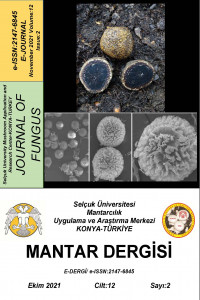Abstract
Determination of the microfungal variety in cosmetic products that have been used is aimed in this study via defining microfungi on cosmetic products used in different storage conditions at the genus level by means of morphological methods. In the study, the cosmetic products used under different conditions for a different period of time were obtained from various consumers. In total, forty products were investigated in groups of blushers, lipsticks, mascaras, eyeshadows, eyeliners, powders, roll-ons and eye-cleaners where each group had five instances. Isolated microfungi obtained in pure culture were incubated at 25°C on PDA medium and then stored as stock culture at +4°C. The microfungi isolated as a result of incubation are identified to the genus level by microscopic and macroscopic examination. The study showed that the dominant genus were Penicillium (Penisilyum) (% 57.9) whereas the others were Aspergillus (Asper) (23.5%), Cladosporium (Havaküfü) (10.3%) and Alternaria (Arıküfü) (8.3%). The product groups in which the most fungal reproduction were seen were eyeshadows (76 colonies), lipsticks (50 colonies) and powders (49 colonies), respectively.
Keywords
References
- Aydogdu, H. ve Asan, A. (2008). Airborne Fungi in the Child Day-Care Centers in Edirne City, Turkey. Environ. Monit. Assessment. 147 (1-3): 423-444.
- Aydogdu, H., Asan, A., Tatman Otkun, M. ve Türe, M. (2005). Monitoring of microorganisms in the indoor air of primary schools in Edirne City, Turkey. Indoor Built Environ. 14 (5): 411-425.
- Chew, F.L., Subrayan, V., Chang, P.P., Goh, M.C. ve Ng, P. (2009). Cladosporium cladosporioides keratomycosis: A case report. Japan J. Ophthalmol. 53: 648-668.
Abstract
Bu çalışmada, çeşitli saklama koşullarında kullanılmış kozmetik ürünlerde bulunan mikrofungusların morfolojik yöntemlerle cins düzeyinde tanımlamaları yapılarak, ürünlerdeki mikrofungal çeşitliliğin tespiti amaçlanmıştır. Çalışmada; farklı süre ve koşullarda kullanılmış kozmetik ürünler kullanıcılardan temin edilmiştir. Bu ürünlerin her birinden 5 er adet olmak üzere ruj, allık, rimel, göz farı, göz kalemi, pudra, göz makyaj temizleme ürünü ve roll-on olarak gruplandırılmış ve toplam 40 adet ürün incelenmiştir. Mikrofungus izolatları saf kültür olarak elde edilip yatık PDA besiyerine pasaj alınarak 25°C'de 7 gün inkübe edilmiş ve daha sonra stok kültür olarak +4°C'de saklanmıştır. İnkübasyon sonucunda izole edilen mikrofungusların makroskobik ve mikroskobik incelemeleri yapılarak cins düzeyinde tespiti yapılmıştır. Çalışma sonucunda baskın fungus % 57.9 oranında Penicillium (Penisilyum) cinsi, % 23.5 oranında Aspergillus (Asper), % 10.3 oranında Cladosporium (Havaküfü) ve % 8.3 oranında Alternaria (Arıküfü) cinsleri tespit edilmiştir. Çalışmada incelenen kozmetik ürünlerden en fazla fungal üreme görülen ürün grupları sırasıyla 76 koloni ile far, 50 koloni ile ruj ve 49 koloni ile pudradır.
Keywords
References
- Aydogdu, H. ve Asan, A. (2008). Airborne Fungi in the Child Day-Care Centers in Edirne City, Turkey. Environ. Monit. Assessment. 147 (1-3): 423-444.
- Aydogdu, H., Asan, A., Tatman Otkun, M. ve Türe, M. (2005). Monitoring of microorganisms in the indoor air of primary schools in Edirne City, Turkey. Indoor Built Environ. 14 (5): 411-425.
- Chew, F.L., Subrayan, V., Chang, P.P., Goh, M.C. ve Ng, P. (2009). Cladosporium cladosporioides keratomycosis: A case report. Japan J. Ophthalmol. 53: 648-668.
Details
| Primary Language | Turkish |
|---|---|
| Journal Section | RESEARCH ARTICLE |
| Authors | |
| Publication Date | October 31, 2021 |
| Published in Issue | Year 2021 Volume: 12 Issue: 2 |
The works submitted to our journals are first judged grammatically. After this phase, articles are sent two reviewers. If necessary, the third reviewer is assessed. In the publication of works, a decision is made by evaluating the level of contribution to science and readers within the criteria specified in the writing rules. Reviewers are requested to submit their assessments within 30 days at the latest. The reviewers' evaluations and the answers to these evaluations are reviewed by the editor and it is decided whether the work will be published or not.
International Peer Reviewed Journal
The journal doesn’t have APC or any submission charges

This work is licensed under a Creative Commons Attribution 4.0 License

